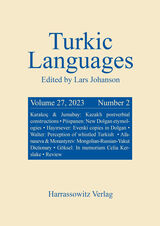Autor: Birsel Karakoç
- «
- 1
- »
Die Suche erzielte 5 Treffer.
Understanding retold stories: The marking of unwitnessed events in bilingual Turkish article
Subordination of existence and possessive clauses in Oghuz and Kipchak Turkic languages article
Two questionable candidates for subordinatorship: -mIşlIK and -mAzlIK in Turkish article
Predicational and sentential positions of interrogative clitics in Turkic article
- «
- 1
- »
